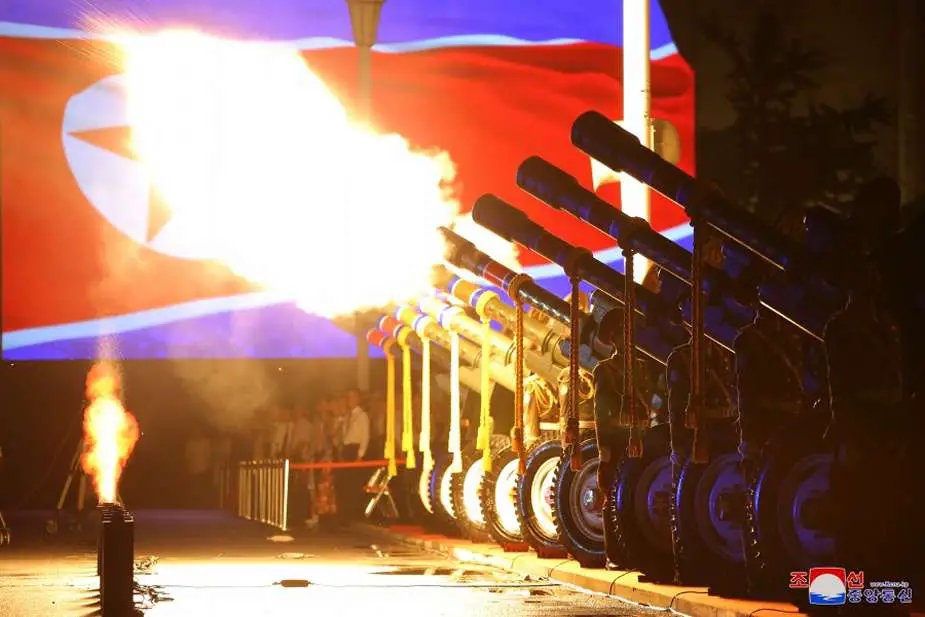On October 5, 2023, a US official informed CBS News that North Korea had initiated the transfer of artillery equipment to Russia, seemingly to support Russia's ongoing involvement in the conflict in Ukraine. Simultaneously, the US Center for Strategic and International Studies (CSIS) issued a report detailing a substantial increase in rail activity between these two nations. These developments align with a prior report from Army Recognition, which had indicated that North Korea was set to commence deliveries of military resources in October.
Follow Army Recognition on Google News at this link

North Korean artillery during a parade in Pyongyang in 2023 (Picture source: KCNA)
Speaking anonymously due to the absence of official announcements, the US official, in conversation with CBS News, has conveyed that North Korea has commenced the transfer of artillery to Russia, seemingly with the intent of enhancing Vladimir Putin's forces during their ongoing 20-month-long invasion of Ukraine. Significant aspects of this transfer remain shrouded in uncertainty, including whether it is a component of a newly established long-term supply chain or a more restricted delivery of weaponry. Furthermore, the precise terms regarding what North Korea is receiving in return for these artillery pieces remain undisclosed, contributing to the overall ambiguity surrounding this development.
The reported support from North Korea to Russia appears to have stemmed from a recent summit held in Moscow, where North Korean leader Kim Jong Un pledged his support for Putin's actions in the ongoing Ukraine conflict, emphasizing full and unconditional backing. Initially, there were expectations that Kim might seek economic assistance, including financial aid and food provisions from Russia, in exchange for his support of Moscow's stance.
Prior to the summit, a South Korean official expressed concerns about Kim potentially seeking technology from Russia to develop nuclear-powered submarines, advanced rockets, satellites, and conventional weaponry, as this deepening of bilateral ties between Russia and North Korea could potentially enhance Kim's capacity to pose threats not only to nearby American allies like South Korea and Japan but also to global stability.
In a parallel development, the U.S. Center for Strategic and International Studies (CSIS) released a report on October 6, 2023, highlighting a dramatic surge in rail traffic at North Korea's Tumangang Rail Facility, located near the Russian border. Satellite imagery captured on October 5, 2023, reveals an unprecedented proliferation of freight railcars at this facility. While the exact nature of the cargo remains concealed due to the extensive use of tarps to cover shipping crates and equipment, this surge in rail traffic is believed to be indicative of North Korea's supply of arms and munitions to Russia, an act that contravenes multiple UN Security Council resolutions.
The CSIS report goes on to suggest that North Korea's intentions extend beyond the resumption of border traffic to pre-COVID-19 levels. Instead, it appears that North Korea is actively expanding the facility's capacity, signifying a potential deepening of its cooperation with Russia. Such military transfers between the two nations could invoke additional sanctions imposed by the United States and its allies.
This information seems to confirm an article from Army Recognition dated September 15, 2023, indicating that North Korea could supply Russia with its artillery systems, including its KN-09 multiple launch rocket system (MLRS), and that North Korea could also supply Russia with a large number of artillery shells. In this article, our editorial team suggested that North Korean deliveries were due to start in October.
The North Korean army is said to have an arsenal of around 21,000 artillery pieces, in particular large-caliber pieces such as 152mm and 122mm, totaling around 8,500 units. In accordance with North Korean doctrine influenced by the Soviet Union, each of these artillery pieces is supposed to have a firing capacity of 45 days. Assuming a conservative estimate of 75 shots per unit per day, the country would therefore have an estimated stockpile of 27 million 122mm/152mm shells. It would therefore be plausible for North Korea to supply Russia with up to 10 million of these shells without encountering major difficulties.
















